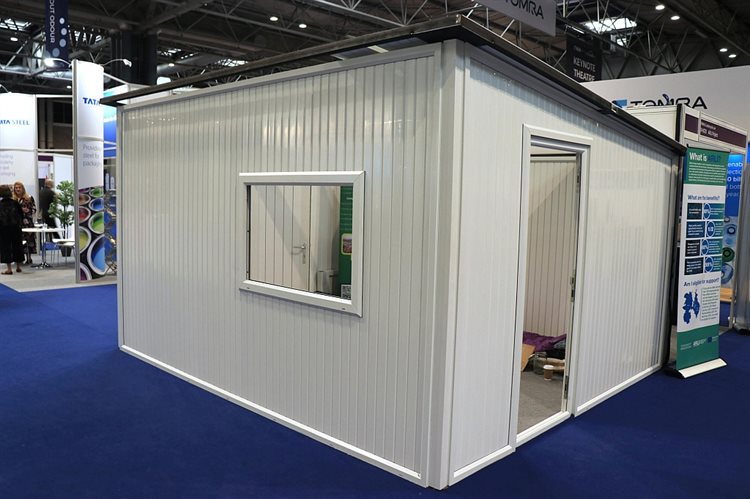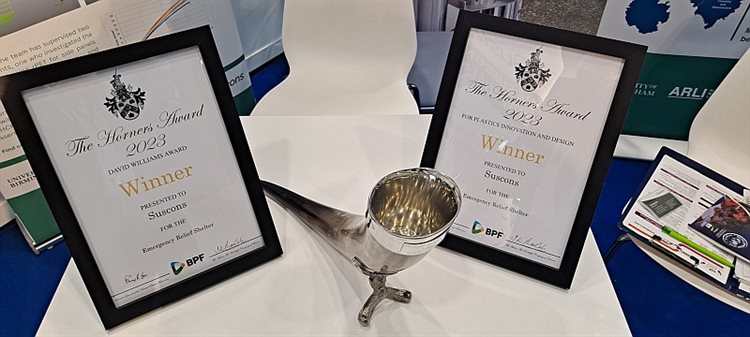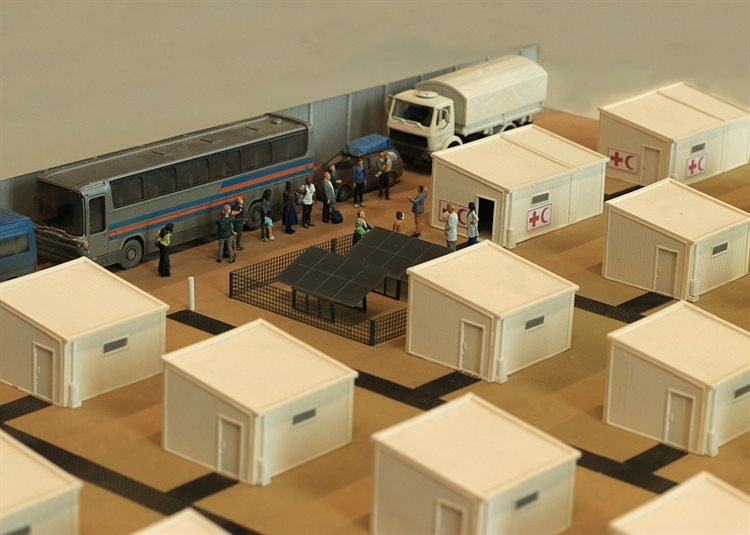The Suscons Emergency Relief Shelter project emerged from a collaboration between Birmingham Plastics Network researchers in the University of Birmingham School of Engineering and Suscons UK Ltd.
It originally started as part of the 6-year Alternative Resources with Low Impact (ARLI) research project looking at converting wastes into useful materials, as well as developing new novel materials. The Emergency Relief Shelter project is the result of 18 months' research and development to create a shelter promoting the circular economy.The shelter is a flatpack, modular system made out of recycled uPVC plastic, designed to both reduce plastic waste and provide a safe, secure alternative to tents within refugee camps. It can also act as a semi-permanent, transitional housing solution. Both of these use cases are designed to aid those displaced by war and natural disaster – over 14 million people each year. The primary purpose of the shelter is to maintain a comfortable temperature for vulnerable inhabitants, as well as keeping them covered and secure.
 A white emergency shelter building made from recycled plastic.
A white emergency shelter building made from recycled plastic.
The shelter is made up of 460kg of waste plastic and can be assembled by unskilled labour in about an hour with no additional fastenings, tools or equipment required. It provides a minimum 2m head height and an internal space of 3.5m x 4.0m, and can accommodate additional features such as solar panels, extra private rooms for medical facilities and a rainwater collection system. Most importantly, it has lockable doors and windows, a 10-year warranty and meets all UNHCR (United Nations High Commissioner for Refugees) guidelines.
Although the shelters are more expensive to purchase than tents, they will work out cheaper over a 10-year period, especially as tents can degrade in storage and become non-viable after 18 months of deployment. There must, however, be a change in the mindset of purchasers to reflect this reality and encourage investment into long-term, sustainable solutions.
Prototypes and models of the shelter have been exhibited at various conferences: AidEx, DIHAD (Dubai International Humanitarian Aid and Development), and at a British Plastics Federation parliamentary reception. The shelter won the Plastics Innovation and Design and the David Williams awards from the Horner’s guild and was a finalist for the GRIPS award for innovative use of polymers and social engagement.
 Framed Honours awards and a silver trophy for the Suscons Shelter.
Framed Honours awards and a silver trophy for the Suscons Shelter.
Why uPVC?
A range of plastics were considered for use in the shelter, and more are up for consideration in the future to improve the structure and it’s insulative properties. However, uPVC is the current material of choice, as it is readily available and saves window and door frames from landfill or fly tipping.
It is Suscons’ belief that:
“uPVC, like all other thermoplastic materials can be recycled and if the right technology is used, even post-consumer, contaminated uPVC window frames and doors can be economically recycled.”
Furthermore, the material is fire resistant and doesn’t flame; testing was done in a fire chamber and the shelter maintained integrity for 30 minutes, allowing sufficient time for escape. This also decreases the potential spread of fire to neighbouring structures.
The uPVC is collected at minimal or no cost to Suscons from across the West Midlands, London, Staffordshire and Shropshire. The collected plastic is then shredded, melted and mixed with a percentage of virgin plastic to ensure chemical quality, and then extruded into the parts needed for the shelter. Materials can also be refabricated from end-of-life shelters, as uPVC can be recycled up to ten times before losing its integrity. The glass collected with the windows and doors can also be sold to recycling companies to offset cost and increase circularity. It also adds the benefit of contributing to humanitarian aid and recycling, as well as avoiding the cost of skips and landfill tax for the fitters.
In the future, Suscons would like to investigate with Birmingham Plastics Network researchers the potential use of alternate plastics, derived from other waste such as plastic packaging, bags and bottles, as these are most likely to be available locally where the shelters are needed. These would be mixed in and extruded with the uPVC, or by themselves, to form sections of the shelter. The ultimate goal of this would involve in-situ facilities where the manufacturing can be done in, or nearer to, the affected countries, utilising local waste plastics and therefore reducing carbon and monetary cost, and providing local employment opportunities for the collection and production facilities.
Uses
Aid agencies including those in the UN, the Red Cross, ICRC (Red crescent), as well as OXFAM, the WHO, Christian Aid, and other local (on a nation by nation basis) agencies have expressed interest in the shelter to help their humanitarian efforts across the globe, including in Ukraine where a tent would be inadequate in the harsh winters. These agencies talk in thousands of units, so a significant amount of post-consumer plastic will be taken out of the waste stream. There are also other possible use cases such as opportunities for temporary buildings in the oil industry, military, and homeless shelters, and these will continue to be explored.
 A small-scale model of a refugee camp using the Suscons Shelter.
A small-scale model of a refugee camp using the Suscons Shelter.
Get in touch
If you would like to discuss this project further, or explore potential opportunities for collaboration, please contact plasticsnetwork@contacts.bham.ac.uk or Hello@Suscons.com.